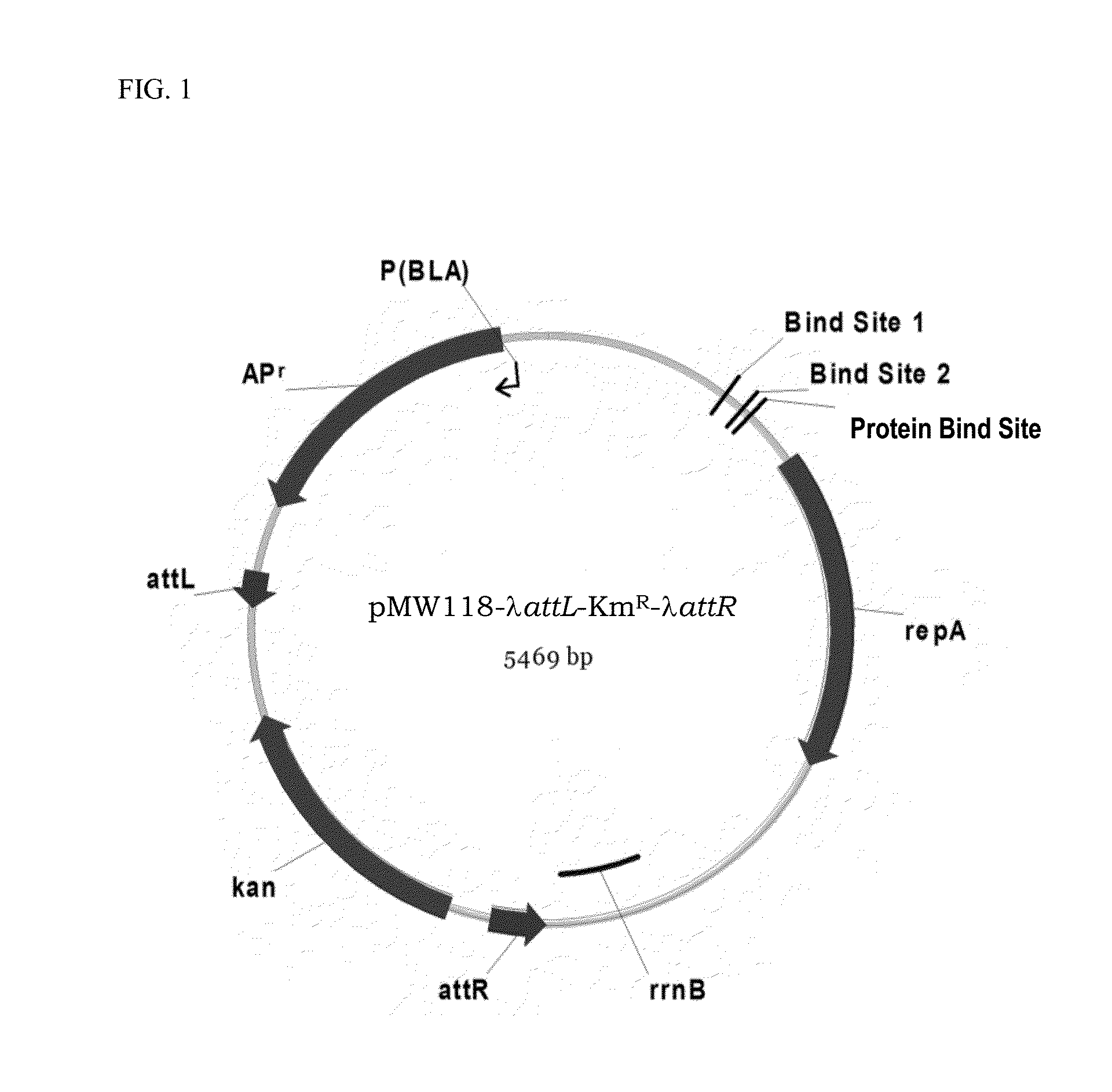Method for Producing an L-Amino Acid Using a Bacterium of the Family Enterobacteriaceae Having Attenuated Expression of a Phosphate Transporter-Encoding Gene
a technology of enterobacteriaceae and phosphate transporter, which is applied in the microbiological industry, can solve the problems of no data reported previously, and achieve the effect of increasing the productivity of l-amino acids
- Summary
- Abstract
- Description
- Claims
- Application Information
AI Technical Summary
Benefits of technology
Problems solved by technology
Method used
Image
Examples
example 1
Construction of the E. coli L-Histidine-Producing Strain Having an Inactivated pitA Gene
[0173]a. Construction of E. coli MG1655ΔpitA Strain
[0174]An E. coli strain having an inactivated pitA gene was constructed by the method initially developed by Datsenko K. A. and Wanner B. L. called “λRed / ET-mediated integration” (Datsenko K. A. and Wanner B. L., Proc. Natl. Acad. Sci. USA, 2000, 97(12):6640-6645). A DNA-fragment containing the kanamycin resistance marker (KmR) was obtained by PCR using primers P1 (SEQ ID NO: 5) and P2 (SEQ ID NO: 6), and the pMW118-λattL-KmR-λattR plasmid (WO2011043485 A1) as the template (FIG. 1). The pMW118-λattL-KmR-λattR plasmid was constructed from the pMW118-attL-TcR-attR plasmid (WO2005 / 010175) by substituting the tetracycline resistance marker gene thereof with the kanamycin resistance marker gene (kan) from pUC4K plasmid (Vieira J. and Messing J., Gene, 1982, 19(3):259-268). Primers P1 and P2 are homologous to both regions adjacent to the pitA gene and ...
example 2
Production of L-Histidine by E. coli MG1655+hisGr hisL′_ΔΔpurR ΔpitA strain
[0179]To test the effect from inactivation of the pitA gene on L-histidine production, the DNA-fragments from the chromosome of the above-described E. coli MG1655ΔpitA strain (Example 1) were transferred to the histidine-producing E. coli strain MG1655+hisGr hisL′_ΔΔpurR by P1-transduction (Miller, J. H. (1972) >, Cold Spring Harbor Lab. Press, Plainview, N.Y.) to obtain the strain MG1655+hisGr hisL′_ΔΔpurR ΔpitA having the KmR-marker. The E. coli strain MG1655+hisGr hisL′_ΔΔpurR is described in Doroshenko V. G. et al., The directed modification of Escherichia coli MG1655 to obtain histidine-producing mutants, Prikl. Biokhim. Mikrobiol. (in Russian), 2013, 49(2):149-154. The deletion of pitA marked with kanamycin resistance gene was verified by PCR as described in Example 1.2.
[0180]E. coli strains MG1655+hisGr hisL′_ΔΔpurR and MG1655+hisGr hisL′_ΔΔpurR ΔpitA were separately cultivated in 2 mL of LB-medium for...
example 3
Production of L-Arginine by E. coli 382 ilvA+ΔpitA Strain
[0185]The E. coli strain 382 ilvA+ was obtained from the arginine-producing E. coli strain 382 (VKPM B-7926, EP1170358 A1) by introducing the wild-type allele of ilvA gene from E. coli K-12 strain by P1-transduction (Miller, J. H. (1972) >, Cold Spring Harbor Lab. Press, Plainview, N.Y.). The E. coli strain 382 was deposited in the Russian National Collection of Industrial Microorganisms (VKPM) (Russian Federation, 117545 Moscow, 1st Dorozhny proezd, 1) on Apr. 10, 2000 under the accession number VKPM B-7926 and then converted to a deposit under the Budapest Treaty on May 18, 2001.
[0186]To test the effect from inactivation of the pitA gene on L-arginine production, the DNA-fragments from the chromosome of the above-described E. coli MG1655ΔpitA strain were transferred to the arginine-producing E. coli strain 382 ilvA+ by P1-transduction to obtain the strain 382 ilvA+ΔpitA having the KmR-marker.
[0187]E. coli strains 382 ilvA+ a...
PUM
| Property | Measurement | Unit |
|---|---|---|
| temperature | aaaaa | aaaaa |
| temperature | aaaaa | aaaaa |
| concentration | aaaaa | aaaaa |
Abstract
Description
Claims
Application Information
 Login to View More
Login to View More - R&D
- Intellectual Property
- Life Sciences
- Materials
- Tech Scout
- Unparalleled Data Quality
- Higher Quality Content
- 60% Fewer Hallucinations
Browse by: Latest US Patents, China's latest patents, Technical Efficacy Thesaurus, Application Domain, Technology Topic, Popular Technical Reports.
© 2025 PatSnap. All rights reserved.Legal|Privacy policy|Modern Slavery Act Transparency Statement|Sitemap|About US| Contact US: help@patsnap.com

